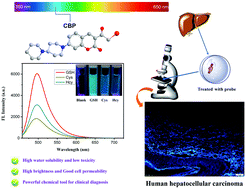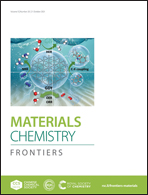A coumarin-based biosensor for human hepatocellular carcinoma diagnosis with enhanced brightness and water solubility†
Abstract
Hepatocellular carcinoma (HCC) is one of the most frequent cancers worldwide, which usually presents at a late stage and has a poor prognosis. Thus, there is an urgent need for the development of an effective and reliable imaging method for detection and surgical navigation. Most modern imaging technologies, such as super-resolution microscopy and single-molecule localization microscopy, utilize traditional dyes, which frequently have poor water solubility, biocompatibility, and brightness. In this work, we aimed to improve the water solubility as well as brightness of coumarin-based fluorophores for detecting biothiols by modifying their donor region. Our results demonstrated that 4-piperidinopiperidine as a donor improved the brightness and water solubility greatly. Next, we applied this probe in living cell imaging. We assumed that this probe could be used to detect an abnormal level of glutathione within hepatocellular carcinoma and tested this belief with human hepatocellular carcinoma, which demonstrated that this probe is a powerful chemical tool that could distinguish tumor tissues from normal tissues. To conclude, the probe we constructed has the potential to serve as a novel tool for the clinical diagnosis of hepatocellular carcinoma.



 Please wait while we load your content...
Please wait while we load your content...